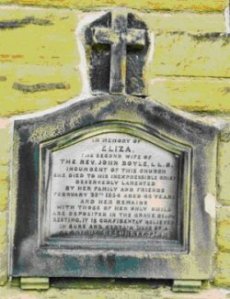The farmland on which the church and grounds sit was feued from the Marquis of Abercorn in 1825 by the church founders Lieut Col Halyburton and his wife Eliza and James and Susannah Rutherford. They rapidly had the ‘chapel’ erected at their own expense and it was opened in May 1828.
The Vestry soon sought the right to open a burying ground around the chapel, but became embroiled in a dispute with the owner of a neighbouring villa who insighted the Kirk Session of Duddingstone, who had also opened a burying ground, to engage in litigation with St Mark’s. The case was eventually decided in favour of St Mark’s and the burying ground was consecrated on 11 November 1828 by Bishop Sandford. The first recorded burial took place a month later.

Celtic cross headstone
Lairs were either purchased or leased for periods of fourteen years after which the Vestry was entitled to make further use of any lair upon which the lease had not been renewed ‘and to cause all Tombstones, Monuments or Tablets placed thereon to be removed’! Purchasers were bound to ‘enclose their respective Lots with Boundary and Division Walls…At least six feet in depth below the surface’. The 1859 Lair Plan shows evidence these walls were erected, however nothing can be seen above ground today.
Early management of the burial ground appears to have been chaotic. The first lair plan was lost and new plans made in 1859, however problems soon arose when lairs in the area immediately behind the church, which believed to be vacant, were found to be occupied.
The problem proved to be so great that the Vestry prohibited all further internments in December 1862, except in Block C and the border on the east boundary wall. Unfortunately it ‘proved difficult to dispose of this ground, as no-one liked the position’.
The consequent shortage of available lairs resulted in plans to remove the trees in the side borders in front of the church so as to use the ground for burials.
Further problems arose at the end of the nineteenth century when the chancel was added to the church. The unusual construction, which can be seen today, arose from the need to span the structure over occupied lairs beneath.
The burial ground continues to be used to this day.
The real interest of the burial grounds is the record of past lives that it provides. In the early eighteenth century there was a large influx of military and naval officers into Portobello. Many of them were Episcopalians and St Mark’s soon became favoured by them. This is reflected in the high occurrence of early momuments dedicated to officers and their families. Of particular note is the memorial in front of the church entrance to Lieut Col Halyburton himself, late of the 7th Royal Fusiliers. More poignant is the recent renewed memorial to Joseph Huey MD Assistant Surgeon, 14th Kings Light Dragoons, erected by his brother officers as a mark of their esteem and regard.
Eight of St Mark’s rectors are buried in the grounds, including the first rector George Maurice Drummond who worked tirelessly for the poor of Portobello through the Portobello Destitute and Sick Society.

Headstone Eliza
There are also records of great loss. That of Rev Boyle who buried two wives in four years. The second ‘died to his inexpressible grief’ and her remains together with those of her only child are buried at the rear of the church.
Close by are the five children of Mr and Mrs Gow, three of whom died in the same year.
In the side border in front of the church is the war grave of Flight Sergeant H I Sandison, Navigator (Bomber), twenty one, who died in a plane crash together with his fellow crew members in 1946. The church sacristy lamp is dedicated to their memory.
We would like to find out more about the people interned within the burial ground. If you have any information please contact the Rector.

Grave stones with daffodils
Further Reading
Annals of Duddingston & Portobello – W Baird 1898
Buildings of Scotland: Edinburgh, Gifford – McWilliam & Walker, 1991
The History of St. Mark’s Church, Portobello 1828-1928 – H W Harris, 1928
Old & New Edinburgh Vol III – J Grant, 1880
Minute books 1828 – 1961 – Publically available at Edinburgh City Archives
Lair Plans 1859 and 1905 – Available by appointment

I am trying to find out where John Tough was buried. The death form just says a registered church yard. He died in 1855 and was living on High Street at the time. If anyone has run across any info I would be greatful.
I am trying to confirm the resting place of my Mother Mary Curry Cook Bryce and my uncle Alexander William Cook. It had been thought that they may have been buried in the grave of Mary Harcus Cook. Is it possible to verify whose remains and ashes are buried in either that grave or possibly that od Fergus Irvine Armstrong?
Thank you for putting the names of the founders Robert & Eliza Halyburton and the Rutherfords into your web page, since our visit to your church last August. As I am descendent from Eliza I am very grateful. If any further information on this couple comes into your hands please share it with me.
Regards
Don Bradford
Australia
what are the family graves at the front of the kirk by the name of broun cheers scott
I have a relative Quinton McIntosh who died in 1855 (in Bridge St, Portobello) and is said to be buried in the Portobello churchyard. Am not sure if this is your churchyard or another.
Andrea, Our records don’t mention a Quinton McIntosh. There were a number of other churchyards around – Old Parish and St James both had graveyards I think (they are both now merged with Portobello and Joppa Parish Church). You could try there.